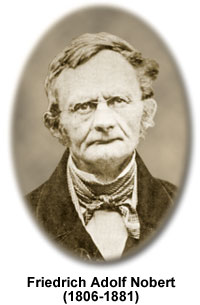Friedrich Adolf Nobert
(1806-1881)

Friedrich Adolph Nobert was born in the Baltic coast town of Barth on January 17, 1806. Being the eldest son of clockmaker Johann Friedrich Nobert, he became a clockmaker as his father did. To fulfill his dreams, he realized that a higher education would be necessary. In order to receive this higher education, he asked the Governor of his providence for a favor of bursary to study at the Technical Institute in Berlin. He made a good case in the fact that, while trying to improve clock-making instruments, he needed to know arithmetic, geometry, and trigonometry. Also, at the age of 21, he submitted a pocket watch he had made to a trade exhibition in Berlin. The watch registered seconds, and had temperature and position correction.
Nobert's work received the commendation of the exhibition judges and the notice of a famous astronomer, Professor Johann Franz Encke, who started a correspondence with the young mechanic. Nobert experienced difficulties in work due to the fact that he would have to use astronomical equipment in order to compare the improvements to the clocks with the stars. He could not afford a telescope and so he had to learn about optics and lens grinding so that he could make his own instruments. He persuaded the governor to grant him 300 Thalers for attending the Technical Institute in Berlin starting October 1, 1833.
The compound microscope's usefulness could not be appreciated at its first inception. Difficulties in construction of the small lenses used in a compound microscope caused aberrations in the images acquired from the microscope. William Tulley was commissioned by Dr. C. R. Goring, in 1824, to build a triple achromatic object glass for the compound microscope. The achievements towards development of the compound microscope were rather incomplete until Joseph Jackson Lister showed that an objective lens could be created so that the spherical aberration could be eliminated. After the publication of Lister's paper in 1830, development of new improvements in optical microscopy followed.
The competition towards the construction of better optical systems in England and the continent grew as a result of Lister's paper. The manufacturers and the users of these new microscopes needed a standard measurement in order to tell weather or not an actual advancement or improvement had been made. Nobert had the patience and instruments necessary to build such an ultra-fine micrometric standard. At the end of a paper about improvements in circle dividing, Nobert mentioned this new idea for the use of such an engine that he had just discovered and suggested the manufacture of very closely and accurately ruled lines cut into glass for use as micrometers by microscopists.
Nobert published his first paper on the micrometric standard in 1846. He stated that it makes sense that nature cannot give appropriate standard objects because of the continuous changes that occur randomly. Nobert attached an apparatus, which held a carefully positioned diamond point, to his circle dividing engine so he could cut parallel ruled sets of lines onto glass. His first test plate, created in 1845, contained ten ruled lines separated by a specific distance. The first line was divided into 1/1000 of a Paris line and the tenth into 1/4000 of a Paris line. In this way, the first resolution test for the compound optical microscope had been created. Nobert packaged a test plate with each microscope he sold in order to popularize the device. Nobert's products were well known from 1845 till the end of the Century. From 1845 to 1873 Nobert had made seven test plates; the ten band plate of 1845, a twelve band plate in 1848, a fifteen band plate in 1849, a twenty band plate in 1851, a thirty band plate in 1855, a nineteen band plate in 1861, and a new twenty band plate in 1873.
Nobert married in the summer of 1835 and had been appointed Universitätsmechaniker at the University of Greifswald earlier that spring. His fame grew as he developed a series of fine ruling techniques in the 1840's. Nobert returned to his family home in Barth soon after his father's death in 1846 to work unassisted until his own death on February 21, 1881.
